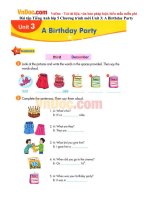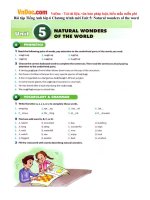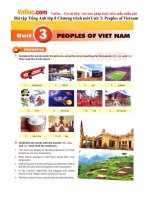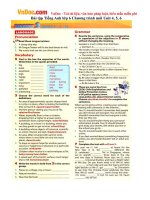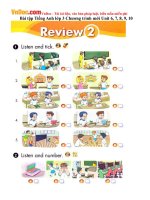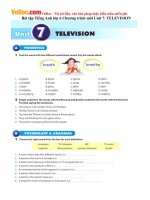Unit 7 Bai tap Tieng Anh 7 Luu Hoang Tri
Bạn đang xem bản rút gọn của tài liệu. Xem và tải ngay bản đầy đủ của tài liệu tại đây (664.43 KB, 10 trang )
Chào các bạn, hiện nay nhằm hỗ trợ cho việc giảng dạy và dễ dàng soạn bài giảng và in ấn, nên
mình đã đánh WORD (khơng phải file PDF) của các sách:
LỚP 6
Bài tập Tiếng Anh 6 (Lưu Hoằng Trí)
Bài tập Tiếng Anh 6 (Vũ Thị Phượng)
LỚP 7
Bài tập Tiếng Anh 7 (Lưu Hoằng Trí)
LỚP 8
Bài tập Tiếng Anh 8 (Lưu Hoằng Trí)
Bài tập Tiếng Anh 8 (Đại Lợi – Hằng Nguyễn)
LỚP 9
Bài tập Tiếng Anh 9 (Thí điểm – Lưu Hoằng Trí)
LỚP 10
Bài tập Tiếng Anh 10 (Vũ Thị Phượng)
Giá của mỗi quyển là 50.000 đồng. Hi vọng các bạn ủng hộ để mình có thêm động lực
cho ra đời các bản word khác nữa nhé. Ngồi ra mình cịn nhận đánh word các sách theo yêu cầu
của mỗi cá nhân nữa nhé.
Mọi thông tin liên hệ:
Gmail:
***
Cảm ơn các bạn đã đọc. Mình xin tặng Unit 7 - Bài tập Tiếng Anh 7 (Lưu Hoằng Trí)
Unit 7: TRAFFIC
A.
I.
1.
2.
3.
4.
5.
PHONETICS
Find the word which has a different sound in the part underlined.
A. head
B. break
C. bread
A. said
B. wait
C. maid
A. start
B. lake
C. station
A. ancient
B. radio
C. nature
A. indicate
B. mistake
C. take
II.
1.
2.
3.
4.
3.
Underline the letters with sound /e/, and circle the letters with sound /ei/.
There used to be many traffic accidents in this street.
Mr. Lake takes the train to work every day.
Betty is walking on the pavement and waving to her friend.
They came to Spain to visit many stadiums and went around by tram.
They were waiting at the railway station to meet their friends from Spain.
B. VOCABULARY & GRAMMAR
Land
Air
………………………………… …………………………………
………………………………… …………………………………
………………………………… …………………………………
………………………………… …………………………………
I. Put the means of transport into the correct groups.
bicycle (bike)
lorry
train
boat
motorbike
tram (streetcar)
bus
plane
underground
car
moped
van
D. heavy
D. sail
D. came
D. village
D. says
Sea
…………………………………
…………………………………
…………………………………
…………………………………
coach
ship
caravan
helicopter
taxi
kayak
II. Put the types of transport into the correct group of the verb. Some types of transport can be used
more than once, and used with the article “a” or “the”.
1. take: ___________________________________________________________________________________
2. get on: _________________________________________________________________________________
3. get off: _________________________________________________________________________________
bus
plane
train
taxi
car
helicopter
bike
horse motorbike
ship
4. go by: __________________________________________________________________________________
5. ride: ___________________________________________________________________________________
III.Match the road signs with their meanings, and then write the correct answers ill blanks.
1. Go ahead only
_____________
9. Trucks prohibited
2. Go left only
_____________
10. All motor vehicles prohibited
3. Go right only
_____________
11. No U-tums
4. No Parking
_____________
12. Overtaking prohibited for trucks
5. Cars prohibited _____________
6. Stop
_____________
7. No Stopping & No Parking
__________
8. Overtaking prohibited
__________
__________
__________
__________
__________
A
B
D
E
F
G
H
I
J
K
L
M
IV. Look at signs A-F. What do they mean? Underline the correct option.
A. Motorbikes don’t have to/ can’t go here. They have to/ don't have to go on another road.
B. You can/ have to park here for free. You can’t/ don’t have to pay for fifteen minutes parking.
FREE
C. Bikes have to/ can keep left. People on foot don’t have to/ can’t walk on the left
D. You can/ can't catch the bus here. You have to/ don't have to wait more than ten minutes.
EVERY
E. You can’t/ don’t have to ride your bike. You can/ have to get off and walk.
F. You can/ can't take a taxi here. You can/ can't park here.
V. Look at the signs, and then do the tasks that follow.
a
b
Mon-Fri, 8.30am-6.30pm
£1.50 for 2 hours
Mon-Fri, 6.30pm-8.30am
Sunday, all day
FREE
c
d
e
ENTRY FEES
f
j
g
h
k
Passport control
Please show your passport
i
l
ADULTS: €10
CHILDREN OVER 5: €4
CHILDREN UNDER 5: FREE
m
A. Which signs might you see:
in the street?____________________
in a hospital?____________________
in a park?_______________________
in a museum? ___________________
at an airport?____________________
B. Complete the sentences with have to, don’t have to, can or can’t, and then match signs a-m to the
sentences below. Sign c has been done for you as an example.
Example: -c- You have to stop.
_______ 1. Dogs
go here.
_______ 2. You
ride a bicycle here, but you
drive your car.
_______ 3. You
pay in the evening or on Sundays.
_______ 4. You
play football here.
_______ 5. You
take photos.
_______ 6. Adults and children over five
pay, but children under five
pay.
_______ 7. You
use this toilet.
_______ 8. You
use Visa or MasterCard but you
use American Express.
_______ 9. You
show your passport.
_______ 10. You
use a mobile in here.
_______ 11. You
walk on the paths, not the grass.
_______ 12. You
smoke in this area.
VI. Complete the following sentences using a different verb or expression. Don’t change the meaning.
Number 0 has been done for you as an example.
0. She never drives to the shops.
She never goes to the shops by car.
1. In bad weather, I take the bus to school.
In bad weather, I
to school
.
2. I always walk to my grandparents’ house.
I always
to my grandparents’ house
.
3. I usually go to school by bike.
I usually
to school.
4. Do you go to school on foot?
Do you
to school?
5. My father usually goes to work by car.
My father usually
to work.
6. My mother drives me to the bus station.
My mother
me to the bus station by
.
VII. Complete the sentences with “used to” or “didn’t use to”.
1. I
like sports, but now I do a lot of different sports.
2. I
be afraid of heights, but then I started climbing hills.
3. I
like putting my head in the water because I couldn’t swim.
4. I
go skating until I met Anna in Switzerland, and then we have practised a lot so
far.
5. I
go to school on foot, but now I ride a bicycle to school.
C. SPEAKING
I. Read the following conversations: five teenagers are talking about their journeys to school. Complete
the table, and then practise asking and answering the three questions about the teenagers.
1. How far is it from his/ her house to the school?
2. How does he/ she go to school?
3. How long does it take him/ her to go to school?
Distance
1. David
kilometers
2. Susan
kilometers
3. Paul
kilometers
4. Ann
kilometers
5. Joe
kilometers
1. David
Interviewer:
David:
Interviewer:
David:
Interviewer:
David:
2. Susan
Interviewer:
Susan:
Interviewer:
Susan:
Time
minutes
minutes
minutes
minutes
minutes
How far do you live from the school?
About one kilometer.
And how do you get to school?
I usually walk to school.
How long does it take?
About 15 minutes.
How far do you live from the school?
I live in a village, about six kilometres away.
How do you get to school?
My dad drives me to school in the morning. He works near the school. But he finishes work
late so I go home by bus.
Interviewer: And how long does it take?
Susan:
About 20 or 25 minutes
3. Paul
Interviewer: How far is it from your house to your school?
Paul:
I live just round the comer - about 200 metres.
Interviewer: So do you go to school on foot?
Paul:
Yes, usually. Or sometimes I go by bike.
Interviewer: How long does it take you to go to school by bike?
Paul:
Just two or three minutes.
4. Ann
Interviewer: How far do you live from the school?
Ann:
I’m not sure - about two or three kilometres, I think.
Interviewer: And how do you get to school?
Ann:
I take the bus. It stops right outside our blocks of flats.
Interviewer: How long does it take?
Ann:
About twenty minutes.
5. Joe
Interviewer: How far do you live from the school?
Joe:
Interviewer:
Joe:
Interviewer:
Joe:
About four kilomefres.
How do you come to school?
I go by underground.
How long does it take?
It takes five minutes to walk to the station, ten minutes on the train, and another five minutes
from the station to the school.
II. Work in pairs. Ask and answer the questions.
1. How
far
is
it
from
your
house
to
the
school?
About
____________________________________________________________________________
.
2. How
do
you
come/
get/
go
to
school?
–
I
____________________________________________________________________________
.
3. How
long
does
it
take?
–
It
____________________________________________________________________________
.
D. READING
I. Read the following passage about driving laws around the world, and then tick the correct answers:
true (T), or false (F).
In Sweden, it is necessary to keep your headlights on 24 hours a day. We understand that it is required for
places as cold as Sweden during winter, but you cannot turn off your car’s lights even if it is June and the
weather looks just fine.
If you are driving in Beijing and you come across a zebra crossing, don’t stop or even try to slow down
because this will get you in trouble with the law.
In Thailand, it is compulsory to wear a shirt while driving. Women who go topless while driving can be
fined equal to a few hundred baht.
In Cyprus, you should keep both hands on the wheel. Drivers who unnecessarily raise a hand from the
steering wheel can get fines, although we think that making some gestures at bad drivers is sometimes good.
Don’t yell or curse while you are driving in Rockville, Maryland, USA although you are right. It is illegal to
curse in public. You have to pay a fine up to $100 or go to prison up to 10 days.
Before you drive off with a car in Denmark, you must check that the children in your car have the best
places. Maybe the reason is that they can read books by Hans Anderson.
Drinking and driving is illegal in Spain, but in Macedonia, if you are drunk, you cannot sit in the front seats.
True False
1. Use your car’s headlights 24 hours a day in Sweden.
2. In Sweden, you have to turn on your car’s lights in June when the weather is bad.
3. In Beijing, it is against the law to stop at a zebra crossing.
4. In Thailand, you have to wear a shirt while driving.
5. There are no rules about what women have to wear while they are driving in Thailand.
6. In Cyprus, you cannot shake your fist (a hand with the fingers and thumb held tightly in)
at other drivers.
7. It is illegal to use bad language while you are driving in Rockville, Maryland, USA.
8. If you yell or curse while you are driving in Rockville, Maryland, USA and don't pay
the fine, you may be put in prison up to 90 days.
9. Children can have best places while they are riding in a car in Denmark.
10. Don’t sit in the front seats if you are drunk in Macedonia, Spain.
II. Read the following text, and then answer the questions.
Bike safety
Children under 10 should always ride with an adult.
You must wear an approved cycle helmet correctly.
Make sure bikes have working brakes.
Wearing a high visibility vest or jacket, especially at night, is a good idea.
You should copy the way you see your parents riding their bikes.
1. At which age can children ride their bikes alone?
________________________________________________________________________________________
2. What must you wear while riding?
________________________________________________________________________________________
3. What should your bike have?
________________________________________________________________________________________
4. What should you wear when you ride at night?
________________________________________________________________________________________
5. Is the way your parents ride their bikes a good example for you to follow?
________________________________________________________________________________________
III.Read the texts about model good road safety behavior at all times for parents, and then answer the
questions.
Top tips for pedestrian safety
Teach your children to hold hands with an adult whenever they go out.
Always use a zebra crossing when one is available and teach children that these are the safest
places to cross.
Teach children that it’s still important to stop, look and listen at a zebra crossing.
Teach children always to stop at the kerb and look and listen for traffic (a third of children
injured on roads said that they didn’t stop before stepping off the kerb and many said they didn’t
look).
Never use your mobile phone while crossing roads.
Children learn to make decisions about crossing the road and parents gradually let them take a
lead when you are crossing together.
As children get older, practise routes with them before they walk alone.
Top tips for cycling
Always encourage children to wear a cycle helmet when they are on their bikes, and set a good
example by wearing one yourself.
Children need to be able to judge speed and distance accurately before they cycle on public
roads. They need to take lessons on cycling in order to travel more widely on their bikes.
Make sure children wear bright coloured clothing and fluorescent items whenever they are
cycling on the road. And if they are cycling in the dark, they will need lights on their bikes and
reflective items too. And of course, make sure you do this yourself, to set a good example.
1. What should children do when they go out?
________________________________________________________________________________________
2. Where should children cross the street?
________________________________________________________________________________________
3. What should children do to cross the street?
________________________________________________________________________________________
4. Where should children stop to look and listen for the traffic?
________________________________________________________________________________________
5. Can they use their mobile phones while crossing roads?
________________________________________________________________________________________
6. What should parents do to help older children before they walk alone?
________________________________________________________________________________________
7. What should children wear when they are on the bikes?
________________________________________________________________________________________
8. What should children do before they cycle on public roads?
________________________________________________________________________________________
9. Which clothes should children wear whenever they are cycling on the road?
________________________________________________________________________________________
10. What should they do when they cycle in the dark?
________________________________________________________________________________________
E. WRITING
Make sentences using the words and phrases given.
1. The traffic/ a nightmare/ visitors/ Viet Nam/ the first time.
________________________________________________________________________________________
2. There/ transport rules/ but/ many people/ not seem/ really interested/ follow/ them.
________________________________________________________________________________________
3. Three or four people/ one motorbike/ a common sight/ particularly/ young people.
________________________________________________________________________________________
4. The traffic/ worst/ rush hours/ when/ everyone/ try/ get to work/ get home quickly.
________________________________________________________________________________________
5. Some people/ ride/ motorbikes/ the pavements/ rather than/ waiting/ a traffic jam.
________________________________________________________________________________________
6. Pedestrians/ get injured/ hit easily/ when/ they/ walk/ the pavements/ cross the roads/ such times.
________________________________________________________________________________________
7. Road users/ very impatient/ quite aggressive/ constantly using their horns/ even shouting/ others.
________________________________________________________________________________________
8. Some people/ install/ air horn/ their motorbikes/ this/ really annoying/ other people/ sometimes/ it/ cause/
accidents.
________________________________________________________________________________________
9. Another problem/ the increase/ the number/ cars/ the road.
________________________________________________________________________________________
10. More people/ own/ private cars/ it/ make/ the problem/ the traffic jams/ worse.
________________________________________________________________________________________

